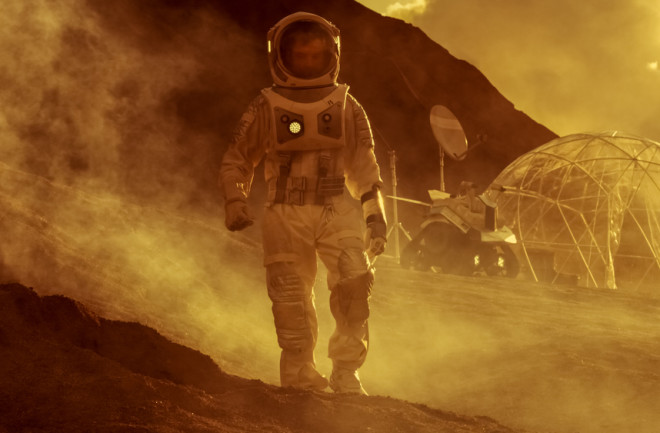Sending humans to Mars has always seemed a distant dream. But in recent years, cheap access to space, the steady arrival of Mars rovers to explore the surface and the ambitions of billionaires like Elon Musk have made the Red Planet feel almost within reach.
All concerned are aware of the huge challenges — from developing the technology to support life during the journey and to safely deliver them to the surface, to bringing them home again. This will be one of the greatest expeditions in human history.
But there is another challenge beyond that is of even greater proportions — the task of colonizing the Red Planet once we get there. Colonization is crucial, say proponents, to create a technology goal for humanity to work towards, to give us greater insight into the nature of the Solar System and ultimately, to create a back-up should we destroy the climate on Earth.
There is no question that this will be a difficult endeavor, perhaps the most difficult that humans have ever undertaken. But the scale and nature of this challenge is poorly understood.
Prospective Colonizers
Now Florian Neukart at the Leiden Institute of Advanced Computer Science in the Netherlands has compiled a comprehensive list of challenges for prospective Mars colonizers along with potential solutions aimed at making the colony self-sustaining. The work, he says, is “a foundational guide for researchers, policymakers, and visionaries aiming to make humanity’s interplanetary future a reality.”
The difficulties in colonizing Mars are legion and Neukart first highlights its vast distance from Earth. That will make resupply missions infrequent and ensure that radio communication has a latency of between 5 and 20 minutes depending on the distance between the two bodies. “Given the prolonged mission durations, immense distances, and resource constraints, traditional "Earth-reliant" approaches to space exploration are not feasible for Martian colonization,” says Neukart.
Then there is the harsh Martian environment, where the temperature varies between a balmy 20 degrees C in summer to -125 degrees C at the poles.
Mars also lacks a magnetic field and this exposes the surface to high levels of radiation from the Sun and from cosmic rays. And every five Earth years or so, Mars famously experiences dust storms that engulf the entire planet for weeks or months at a time.
Because of the thin atmosphere, these storms do not involve high winds like those on Earth. But the dust they spread is extremely fine, having the consistency of talcum powder, and this poses unique problems, such as covering solar panels or gumming up sensitive mechanisms not to mention making navigation tricky.
For each of these problems, Neukart examines the potential impact on humans and then lists forms of mitigation. For example, elevated radiation levels can cause cancer and radiation sickness in humans while also impacting fertility.
Making habitats out of materials that shield from radiation will be important. These materials include hydrogen-rich substances such as water, polyethylene, or hydrogen-rich boron nitride nanotubes. Underground habitats will also provide protection and various drugs are available that can limit the effect of radiation on humans or boost repair mechanisms.
Researchers have also begun to work out how to make concrete on Mars using widely available sulfur as a binding agent. That should be sustainable but raises questions about its durability and its potential toxicity for humans, which may require it to be covered by other layers.
Humans will need power, potentially from solar panels, although there is about half as much sunlight in mars compared to Earth. Nuclear is another option but the low density of the atmosphere makes wind power less useful.
Water Hunt
And no small challenge will be finding water, which is thought to be abundant in frozen form beneath the surface. Growing food in the absence of soil or suitable atmosphere will also be difficult.
Neukart raises the prospect of plants grown using aeroponics — growth without soil by misting the roots with nutrient-rich water. Other options include bioreactors for algae or indeed, any kind of cell that can be grown into food. These will need a constant source of feedstocks and nutrients though where these will come from is less clear.
The psychological impact of one-way trips to Mars should not be underestimated either. “The psychological stressors of living in such conditions — far removed from the familiar surroundings of our home planet — can lead to a myriad of issues, from depression and anxiety to interpersonal conflicts,” says Neukart.
Last but not least is the cost of this endeavor. Rocket launches, technology development, resupply and so on, are all costs that are hard to quantify but clearly lie on a scale beyond those of current space exploration.
But there are commercial opportunities too. Mars colonies could eventually generate income from tourism, from real estate development and from inter-planetary trade. Somebody someday is going to make a lot of money on Mars. “Mars colonization presents a frontier not just for scientific exploration but also for economic opportunities,” says Neukart.
That’s interesting work that begins to chart the scale of the endeavor. Neukart is the first to admit that significantly more work is needed to better understand these challenges.
But journeys like this are only made one step at a time and Neukart appears optimistic: “As the contours of space exploration in the 21st century become sharper focus, Mars emerges not as a distant, aspirational target but as a tangible frontier for human colonization.” Good luck!
Ref: Towards Sustainable Horizons: A Comprehensive Blueprint for Mars Colonization : arxiv.org/abs/2309.16806

